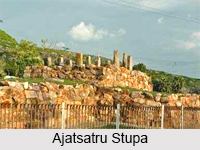 Ajatsatru Stupa is known as the fort of Ajatashatru and the royal abode of Ajatshatru. Ajatshatru became the king of Magadha, after he jailed his father Bimbisara, which is known as Bimbisara Jail.
Ajatsatru Stupa is known as the fort of Ajatashatru and the royal abode of Ajatshatru. Ajatshatru became the king of Magadha, after he jailed his father Bimbisara, which is known as Bimbisara Jail.
Location of Ajatshatru Stupa
Ajatsatru Stupa is located to the west of Rajgir, on the other side of the Sarasvati River.
Archaeological Site of Ajatsatru Stupa
Ajatsatru Stupa is a large mound which marks the site of a stupa, that of Ajatasatru according to Fahien and of Ashoka according to Hiuen Tsang. The mound of Ajatshatru Stupa was 10 metres high at the east end but less on other sides when it was excavated by the Archaeological Survey of India in 1905-1906.
Excavation of Ajatsatru Stupa
The excavation of Ajatshatru Stupa done by Archaeological Survey of India in the year 1905-1906, revealed bricks supposed to be of the typical Mauryan type at a depth of 3.5 metres in the western part of the mound, which had been re-used in the construction of a later building.
Mound of Ajatsatru Stupa
Ajatsatru Stupa is now in the form of mound. About the middle of the mound were found the remains of three late stupas and some mortar-pits. In the western part of the mound, which was opened down a depth of 3 metres only, were the remains of some brick walls, and in the earth round about and above them were found a number of miniature clay stupas, about 5 cm high and 2.5 cm in diameter. Inside each of these miniature stupas was a tiny clay tablet with the teachings of Gautama Buddha inscribed in characters of the eighth or ninth century.
Miniature Stupas of Ajatsatru Stupa
The presence of Ajatsatru Stupas suggests that a large stupa, the core of which consisted of earth and debris, was built over the remains of the brick walls. King Ajatasatru built another stupa to the east of Venuvana. This stupa must be sought for very near Venuvana, as the Manjusrimulakalpa says that it was within the Venuvana area. In that case it may be represented by the mound to the left of the modern road, the stone bases of which are still to be seen and on which stand some stone pillars of much later date.



















